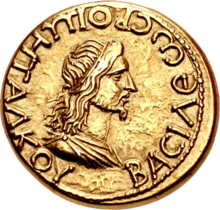| T. J. Cotys II | |
|---|---|
 Gold stater of the Bosporan king Cotys II, legend BACΙΛΕΩC ΡΟΙΜΗΤΑΛΚΟΥ. (Οther side: head of Hadrian, year ΥΚΓ΄ = 423 = 126/7) 19 mm, 7.78 g. | |
| King of the Bosporus | |
| Reign | 123 - 131 |
| Predecessor | T. J. Sauromates I |
| Successor | T. J. Rhoemetalces |
| Died | 131 |
| Issue | T. J. Rhoemetalces T. J. Eupator |
| Dynasty | Tiberian-Julian |
| Father | T. J. Sauromates I |
Cotys II or Kotys II (Greek: Τιβέριος Ἰούλιος Κότυς Β' Φιλοκαῖσαρ Φιλορωμαῖος Eὐσεβής, Tiberios Iulios Kotys Philocaesar Philoromaios Eusebes, flourished 2nd century, died 131) was a prince and Roman client king of the Bosporan Kingdom. Like many other later Bosporan kings, Cotys II is known mainly from coinage, alongside a few inscriptions and contemporary writings. His coins are known from the period 123–131.[1] Cotys II is known to have been the son of his predecessor Sauromates I.[2] His relationship to later kings is not known for certain, but it is possible that his two immediate successors Rhoemetalces and Eupator were his sons.[2]
During his reign, the city of Chersonesus Taurica was under his direct control. Cotys II is mentioned in the writings of the Roman Historian Arrian and was a contemporary to the rule of the Roman emperor Hadrian.
See also[edit]
Sources[edit]
- ^ Mitchiner, Michael (1978). The Ancient & Classical World, 600 B.C.-A.D. 650. Hawkins Publications. p. 69. ISBN 978-0-904173-16-1.
- ^ a b Settipani, Christian (2006). Continuité des élites à Byzance durant les siècles obscurs: les princes caucasiens et l'Empire du VI:e au IX:e siècle (in French). Paris: De Boccard. p. 408. ISBN 978-2-7018-0226-8.
Well, that’s interesting to know that Psilotum nudum are known as whisk ferns. Psilotum nudum is the commoner species of the two. While the P. flaccidum is a rare species and is found in the tropical islands. Both the species are usually epiphytic in habit and grow upon tree ferns. These species may also be terrestrial and grow in humus or in the crevices of the rocks.
View the detailed Guide of Psilotum nudum: Detailed Study Of Psilotum Nudum (Whisk Fern), Classification, Anatomy, Reproduction